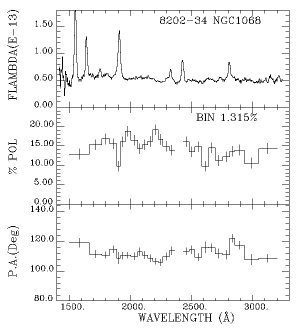|
|||||||||||||||||||
|
|
|||||||||||||||||||
|
|
About WUPPE
The Wisconsin Ultraviolet Photo-Polarimeter (WUPPE) was a shuttle-borne instrument used to obtain polarization and spectrophotometry in the UV. It was part of the ASTRO payload complement of three co-mounted instruments that flew in December 1990 and March 1995 as Space Shuttle missions. WUPPE was a project of the University of Wisconsin Space Astronomy Laboratory. The Principal Investigator was Arthur D. Code.
WUPPE obtained medium resolution spectropolarimetry to study the interstellar medium, hot stars, stars with circumstellar material, interacting binaries, novae, solar system objects, and active galaxies. It was a unique instrument, obtaining a large amount of the ultraviolet spectropolarimetry data currently available.
WUPPE obtained simultaneous spectral and polarization measurements from 1400 to 3300 Å. The instrument included a 0.5m f/10 Cassegrain telescope and a modified Monk-Gilleson spectropolarimeter. Two rotating wheels were used to select the focal plane aperture and the polarimetric analyzer. A magnesium fluoride Wollaston polarizing beam-splitter placed between the aperture and the relay mirror split the beam into two orthogonally-polarized spectra. The detector consisted of dual Reticon arrays of 1024 pixel photodiodes coupled by fiber optics to a microchannel plate intensifier. A set of halfwave plates at 6 different angles provided spectropolarimetric modulation with 16 Å spectral resolution. In addition, a Lyot analyzer was used to provide low resolution (50-100 Å) spectropolarimetry on fainter objects. However the Lyot had calibration problems and no useful polarimetry data were obtained from that mode.
During ASTRO 1, WUPPE obtained 98 observations of 75 targets. Thirty-three of the observations resulted in usable polarimetric data (as well as spectroscopy). Forty-two of the pointings resulted in only UV spectra. During ASTRO 2, WUPPE obtained 369 observations of 254 targets. One hundred-fifty of the pointings resulted in polarimetric data. Forty-seven pointings produced only UV spectra.
For more information about WUPPE, please see the WUPPE project web site: http://www.sal.wisc.edu/WUPPE/.
| Example of a WUPPE Spectrum |
|---|

|
| Example taken from link on WUPPE Project observation log page. |
|
|
|




 Follow Us
Follow Us